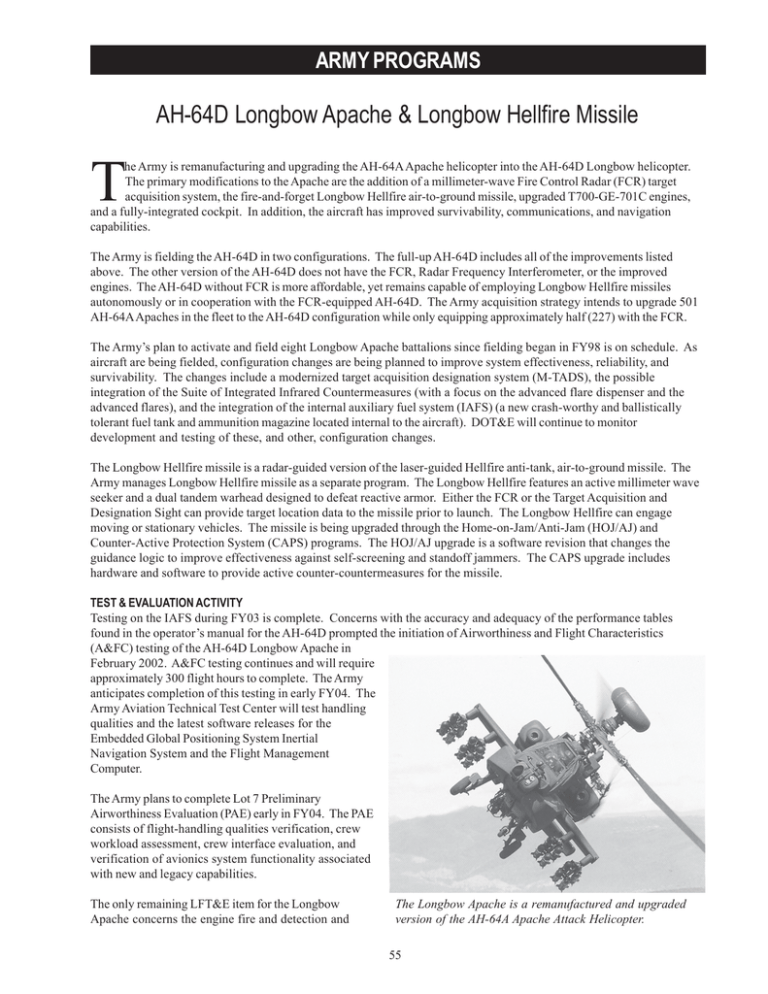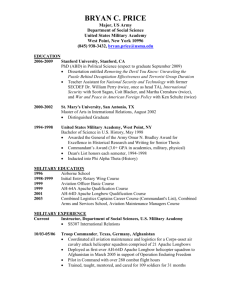T AH-64D Longbow Apache & Longbow Hellfire Missile ARMY PROGRAMS
advertisement

ARMY PROGRAMS AH-64D Longbow Apache & Longbow Hellfire Missile T he Army is remanufacturing and upgrading the AH-64A Apache helicopter into the AH-64D Longbow helicopter. The primary modifications to the Apache are the addition of a millimeter-wave Fire Control Radar (FCR) target acquisition system, the fire-and-forget Longbow Hellfire air-to-ground missile, upgraded T700-GE-701C engines, and a fully-integrated cockpit. In addition, the aircraft has improved survivability, communications, and navigation capabilities. The Army is fielding the AH-64D in two configurations. The full-up AH-64D includes all of the improvements listed above. The other version of the AH-64D does not have the FCR, Radar Frequency Interferometer, or the improved engines. The AH-64D without FCR is more affordable, yet remains capable of employing Longbow Hellfire missiles autonomously or in cooperation with the FCR-equipped AH-64D. The Army acquisition strategy intends to upgrade 501 AH-64A Apaches in the fleet to the AH-64D configuration while only equipping approximately half (227) with the FCR. The Army’s plan to activate and field eight Longbow Apache battalions since fielding began in FY98 is on schedule. As aircraft are being fielded, configuration changes are being planned to improve system effectiveness, reliability, and survivability. The changes include a modernized target acquisition designation system (M-TADS), the possible integration of the Suite of Integrated Infrared Countermeasures (with a focus on the advanced flare dispenser and the advanced flares), and the integration of the internal auxiliary fuel system (IAFS) (a new crash-worthy and ballistically tolerant fuel tank and ammunition magazine located internal to the aircraft). DOT&E will continue to monitor development and testing of these, and other, configuration changes. The Longbow Hellfire missile is a radar-guided version of the laser-guided Hellfire anti-tank, air-to-ground missile. The Army manages Longbow Hellfire missile as a separate program. The Longbow Hellfire features an active millimeter wave seeker and a dual tandem warhead designed to defeat reactive armor. Either the FCR or the Target Acquisition and Designation Sight can provide target location data to the missile prior to launch. The Longbow Hellfire can engage moving or stationary vehicles. The missile is being upgraded through the Home-on-Jam/Anti-Jam (HOJ/AJ) and Counter-Active Protection System (CAPS) programs. The HOJ/AJ upgrade is a software revision that changes the guidance logic to improve effectiveness against self-screening and standoff jammers. The CAPS upgrade includes hardware and software to provide active counter-countermeasures for the missile. TEST & EVALUATION ACTIVITY Testing on the IAFS during FY03 is complete. Concerns with the accuracy and adequacy of the performance tables found in the operator’s manual for the AH-64D prompted the initiation of Airworthiness and Flight Characteristics (A&FC) testing of the AH-64D Longbow Apache in February 2002. A&FC testing continues and will require approximately 300 flight hours to complete. The Army anticipates completion of this testing in early FY04. The Army Aviation Technical Test Center will test handling qualities and the latest software releases for the Embedded Global Positioning System Inertial Navigation System and the Flight Management Computer. The Army plans to complete Lot 7 Preliminary Airworthiness Evaluation (PAE) early in FY04. The PAE consists of flight-handling qualities verification, crew workload assessment, crew interface evaluation, and verification of avionics system functionality associated with new and legacy capabilities. The only remaining LFT&E item for the Longbow Apache concerns the engine fire and detection and The Longbow Apache is a remanufactured and upgraded version of the AH-64A Apache Attack Helicopter. 55 ARMY PROGRAMS suppression system (FDSS) test. The FDSS test, required by the Apache Longbow Test and Evaluation Master Plan, is being deferred so that it might be conducted with the Army Aviation Halon replacement. However, since a suitable dropin halon replacement is not forthcoming, the Program Management Office is in the process of planning to conduct this test with the existing Halon 1301 system. The Army intends to use a fully operational representative, but not flightworthy, aircraft as the ground test article to conduct this series of tests in 2QFY04. The Army conducted ten Hellfire missile flight tests in FY03 to support the HOJ/AJ software regression testing and determine its effectiveness in countermeasure environments. Analysis of this testing is ongoing with results expected during 2QFY04. For the CAPS upgrade, pre-qualification testing was conducted in FY03 to address the radome design, antenna design, effective radiated power, guidance section performance, and radar cross-section. Because the CAPS is added to the exterior of the existing missile, aerodynamic impacts of the upgrade are being studied; sub-scale wind tunnel testing was proposed for FY04. Opportunities to analyze and evaluate the effectiveness, suitability, and survivability of the AH-64A/D aircraft under combat conditions abounded during operations in FY02 against al Qaeda and Taliban fighters in Afghanistan and in FY03 during Operation Iraqi Freedom. TEST & EVALUATION ASSESSMENT The Army found the IAFS effective and suitable and is fielding the subsystem. This addition/modification to the aircraft provides the units in the field with an aircraft that has an extended range capability with a fuel system that is crashworthy and ballistically tolerant. This is a much-needed improvement in the system, even though 30 millimeter round carrying capability is reduced from 1,200 rounds to 300 rounds due to the modification. As expected, the A&FC aircraft testing confirms that the published performance charts for the AH-64D need refinement, but the magnitude and extent of the changes is not yet known. Early results of ongoing software regression testing show no significant anomalies. The Lot 7 interoperability assessment confirms the aircraft’s ability to send/receive joint variable message format and tactical fire direction system messages. In-flight workload assessment surveys and low airspeed testing are complete. Testing of the final software configuration is complete and a safety confirmation recommendation was forwarded to the Army Developmental Test Command for approval. Four missile flights supported software regression testing and evaluation under benign conditions while six additional missile flights provided data to demonstrate HOJ/AJ performance under electronic countermeasure (ECM) conditions. Analysis is ongoing to reconcile differences between pre-flight predictions and actual flight-test results for at least one of the six ECM flights. A test report and simulation verification and validation report are expected in early CY04. “Rocket Ball” testing, a series of contractor-run engineering tests, reportedly confirmed good radio frequency performance of three CAPS prototype systems. This series of tests also showed that there was no discernable difference in performance due radome-to-radome variability. There was a small increase in baseline radar cross section with the addition of CAPS to the missile. The ERP test showed that the design has sufficient radio frequency performance margin. Results of recent combat deployments and training exercises confirm the results of the 1995 IOT&E assessment for the Longbow Apache helicopter - the AH-64D helicopter provides effective air-to-ground combat power. The Army afteraction reports from the Iraqi conflict conclude that the Longbow Apache aircraft survives, protects the crew, and can be quickly repaired and returned to combat. Still, improvements to the Apache aircraft and training devices could enhance the aircraft’s effectiveness. The Army should consider accelerating the procurement and fielding of M-TADS to enable target identification at standoff ranges. Additionally, the Army should incorporate “running/diving fire” engagement tactics, techniques, and procedures, as well as dynamic engagements during peacetime training. This training would be especially beneficial in the Longbow qualification training at Fort Rucker, Alabama, and during unit aerial gunnery training. 56



